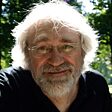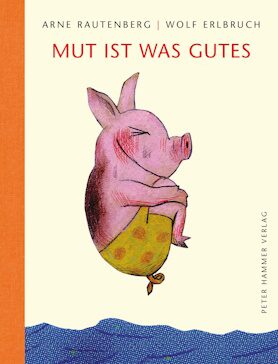Arne RautenbergWolf Erlbruch
Mut ist was Gutes
[Courage is a Good Thing]
- Peter Hammer Verlag
- Wuppertal 2023
- ISBN 978-3-7795-0712-3
- 48 Pages
- Publisher’s contact details
This book was showcased during the special focus on Italian (2022 - 2024).
“…that there’s happiness in life”
Arne Rautenberg / Wolf Erlbruch: Mut ist was Gutes [Courage is Something Good]
These pictures! They open a whole universe full of associations and inspirations! It’s totally understandable that the poet—in this case Arne Rautenberg—immediately felt the need to reach for his pen and document what occurred to him from Wolf Erlbruch’s little human animal characters. And it made no difference whether what came to mind was a pure or impure rhyming scheme: “laut schlagen zwei herzen in meiner brust / das eine sagt lass es das andre du musst” [two hearts beat loudly in my breast / the one says let it be the other says you must].
Addressed are situations that we all—young and old—have experienced, or better yet, have endured. Challenges, especially tests of courage, that made our hearts sink into our boots and where we simultaneously got exciting butterflies in our stomachs, as if we were sitting in a rollercoaster just before the drop. Courage is Something Good is about the pleasurable sensation of overcoming what normally strikes us with fear, which gets in the way when you’re full of curiosity and want—or need—to try something totally new.
With his distinctive illustrations, Wolf Erlbruch, who died in 2022 and received the Astrid Lindgren Memorial Award in 2017, inspires every viewer to continue spinning the yarn of his captured moments with their own experiences. At the same time, the artist has a striking way of placing his creatures—exclusively animals—in the picture. In the foreground is the event, caricatured through strokes and colors with only what’s essential. The background is empty—a nothingness, yellow ochre in color. The viewer thus concentrates on what’s immediately happening: a dance on a tightrope. A split second on a 5-meter platform’s diving board. A secretly witnessed kiss.
Memories and associations arise practically on their own. You see a lively little piglet in swimming trunks right before splashing its behind into the cool water. And you immediately think of an event you experienced yourself. Arms closed tightly around your knees. A wide grin on your face that suggests pleasure, excitement, and fear of the moment in equal measure. Or: the little owl with eyes wide from fear and a scarf flying behind it clinging to the handlebars of a bicycle that’s speeding faster and faster downhill. In the back, on the luggage rack, is the rabbit grasping the pole of the seat, its ears flapping in the wind. He puts his faith in the owl’s steering abilities. What else can he do? “step on it! / let’s ride! / with a howl! / you owl! / it’s a blast! / yeah, rabbit! / don’t talk baloney! / let’s go! / let’s rip! / let’s rock! / let’s roll! / whoever sees us! / will adore us!” Now if that doesn’t make you think of the scrapes on your knee from wild rides on a velocipede!
The most touching scene for the writer of these lines is where the kitten and its grandmother are sitting next to each other on the sofa. Having already strapped on its skis, the kitten’s round, shining eyes are full of joyful anticipation about what’s coming. Meanwhile, the grandmother is knitting a scarf for her grandchild with lowered eyes. Both are very present but at the same time somewhere else entirely. The child already has the imminent descent down the snow-covered slope in mind. The grandmother is perhaps remembering a joyful experience from her own childhood. Anticipation here, recollection there—and both sitting side by side “between not sure yet and do you remember,” as Arne Rautenberg calls his poem. “anticipation dreams away: / as soon as i get on my way … / recollection looks backwards: / it was really lovely then … / in this conflict both can agree / that there’s happiness in life.”
That there’s happiness in life is something the visual artist and poet insist on in their inimitable narrative styles. Wolf Erlbruch with his thoroughly likeable animal personalities, whose humanity and overt and covert peculiarities can be seen at first glance. And Arne Rautenberg in his games of make-believe articulates the situations his creations have accidentally or purposefully fallen into with delightfully light-footed words; words that get to the heart of happiness—and thus also to the courage of the moment. Whether they’re rhymed or not.

These pictures! They open a whole universe full of associations and inspirations! It’s totally understandable that the poet—in this case Arne Rautenberg—immediately felt the need to reach for his pen and document what occurred to him from Wolf Erlbruch’s little human animal characters. And it made no difference whether what came to mind was a pure or impure rhyming scheme: “laut schlagen zwei herzen in meiner brust / das eine sagt lass es das andre du musst” [two hearts beat loudly in my breast / the one says let it be the other says you must].
Addressed are situations that we all—young and old—have experienced, or better yet, have endured. Challenges, especially tests of courage, that made our hearts sink into our boots and where we simultaneously got exciting butterflies in our stomachs, as if we were sitting in a rollercoaster just before the drop. Courage is Something Good is about the pleasurable sensation of overcoming what normally strikes us with fear, which gets in the way when you’re full of curiosity and want—or need—to try something totally new.
With his distinctive illustrations, Wolf Erlbruch, who died in 2022 and received the Astrid Lindgren Memorial Award in 2017, inspires every viewer to continue spinning the yarn of his captured moments with their own experiences. At the same time, the artist has a striking way of placing his creatures—exclusively animals—in the picture. In the foreground is the event, caricatured through strokes and colors with only what’s essential. The background is empty—a nothingness, yellow ochre in color. The viewer thus concentrates on what’s immediately happening: a dance on a tightrope. A split second on a 5-meter platform’s diving board. A secretly witnessed kiss.
Memories and associations arise practically on their own. You see a lively little piglet in swimming trunks right before splashing its behind into the cool water. And you immediately think of an event you experienced yourself. Arms closed tightly around your knees. A wide grin on your face that suggests pleasure, excitement, and fear of the moment in equal measure. Or: the little owl with eyes wide from fear and a scarf flying behind it clinging to the handlebars of a bicycle that’s speeding faster and faster downhill. In the back, on the luggage rack, is the rabbit grasping the pole of the seat, its ears flapping in the wind. He puts his faith in the owl’s steering abilities. What else can he do? “step on it! / let’s ride! / with a howl! / you owl! / it’s a blast! / yeah, rabbit! / don’t talk baloney! / let’s go! / let’s rip! / let’s rock! / let’s roll! / whoever sees us! / will adore us!” Now if that doesn’t make you think of the scrapes on your knee from wild rides on a velocipede!
The most touching scene for the writer of these lines is where the kitten and its grandmother are sitting next to each other on the sofa. Having already strapped on its skis, the kitten’s round, shining eyes are full of joyful anticipation about what’s coming. Meanwhile, the grandmother is knitting a scarf for her grandchild with lowered eyes. Both are very present but at the same time somewhere else entirely. The child already has the imminent descent down the snow-covered slope in mind. The grandmother is perhaps remembering a joyful experience from her own childhood. Anticipation here, recollection there—and both sitting side by side “between not sure yet and do you remember,” as Arne Rautenberg calls his poem. “anticipation dreams away: / as soon as i get on my way … / recollection looks backwards: / it was really lovely then … / in this conflict both can agree / that there’s happiness in life.”
That there’s happiness in life is something the visual artist and poet insist on in their inimitable narrative styles. Wolf Erlbruch with his thoroughly likeable animal personalities, whose humanity and overt and covert peculiarities can be seen at first glance. And Arne Rautenberg in his games of make-believe articulates the situations his creations have accidentally or purposefully fallen into with delightfully light-footed words; words that get to the heart of happiness—and thus also to the courage of the moment. Whether they’re rhymed or not.

By Siggi Seuß
Siggi Seuß, freelance journalist, radio script writer and translator, has been writing reviews of books for children and young people for many years.
Publisher's Summary
For those who take their courage in both hands and overcome procrastination, real elation awaits!
Wolf Erlbruch has captured this special moment in ravishing images.
Arne Rautenberg has been inspired by them to write enjoyable poems.
(Text: Peter Hammer Verlag)
